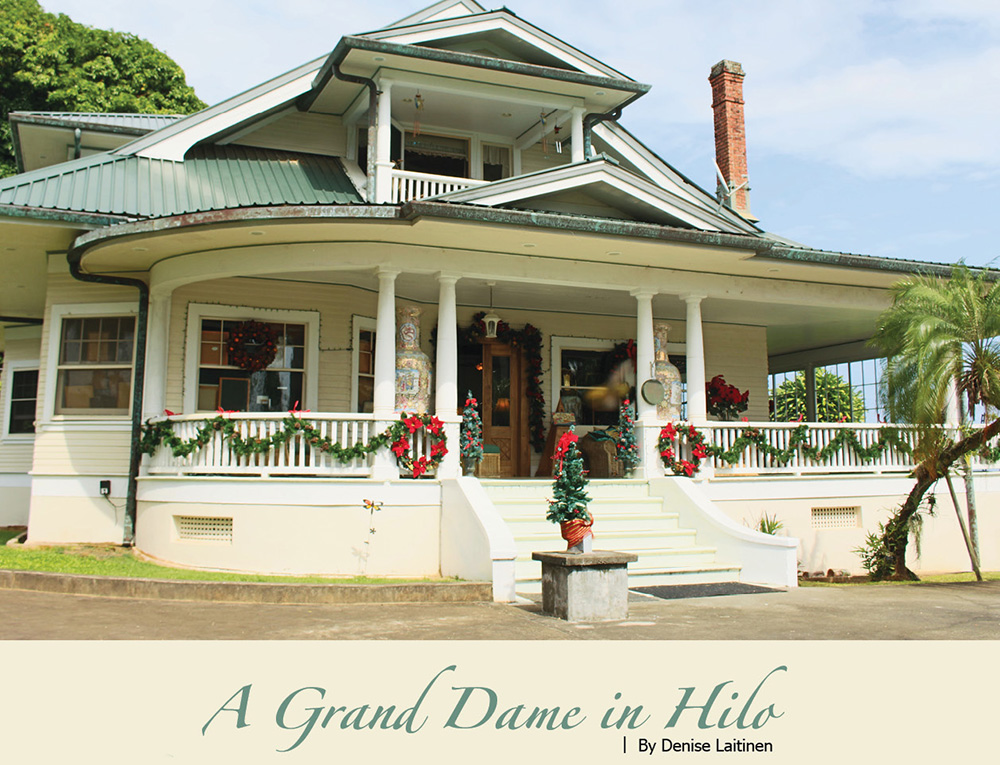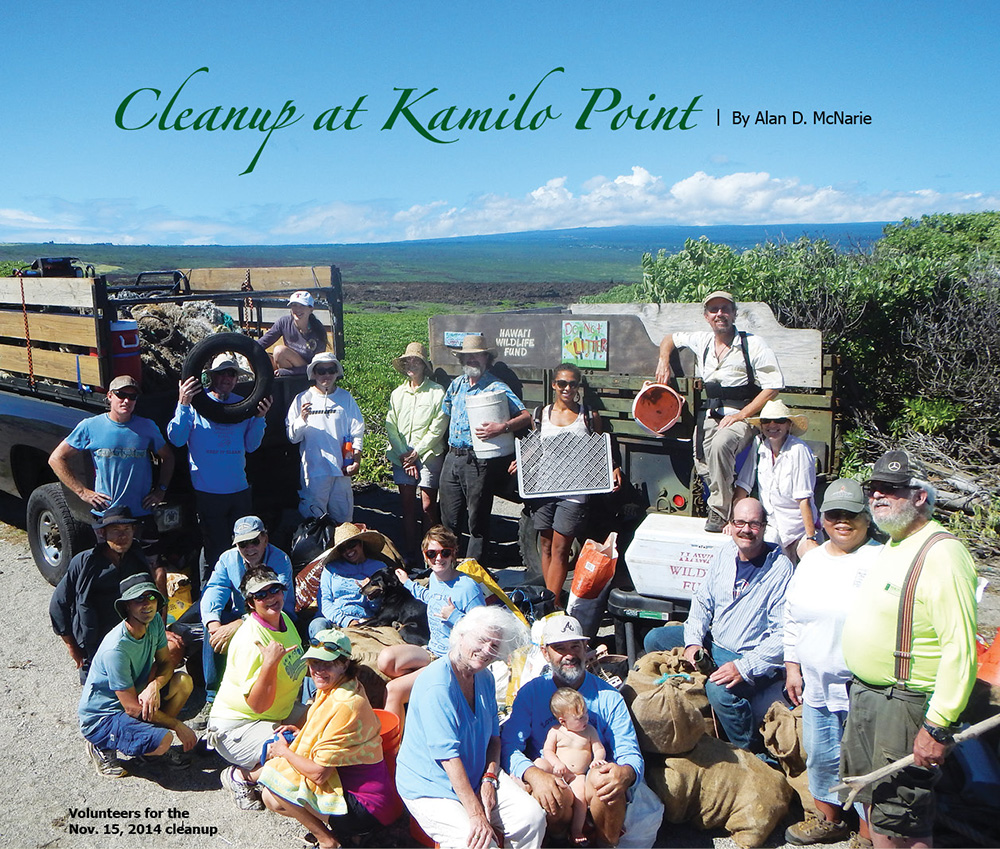
A Grand Dame in Hilo

By Denise Laitinen
When Lorraine Shin first set eyes on the sprawling Victorian perched atop the hill at the end of Puueo Street in Hilo, she knew the house was an absolute treasure.
“You could see the beauty and charm of the house, the old style kama‘āina home,” recalls Lorraine about first seeing the large house with commanding views of Hilo Bay and downtown Hilo.
To be sure, the house didn’t look like a treasure at the time. Built in 1912, by the time Lorraine saw it in the late 1970s the two-story home had fallen into ruin.
“The house resembled a huge, run down haunted house. Almost every window was broken, there was graffiti on the walls, and the house was full of rats,” says Lorraine.
It was a far cry from when Harold Patten and his wife, Carolyn Macy Patten first built what would become one of the finest homes in Hilo.
Originally from Nova Scotia, Canada, Harold fell in love with Hawai‘i, and shortly after arriving in Hilo became a manager for the First Bank of Hilo, which later merged with Bank of Hawaii. In 1892, Harold married Carolyn Macy of Hāmākua and the couple had three children.
Harold and Carolyn built a large home on a 3.8-acre property they purchased just north of the Wailuku River. Carolyn is quoted in a 1964 Tribune Herald newspaper interview stating that she and Harold selected the property at the intersection of Puueo and Kauila Streets because at the time it was surrounded by pineapple fields and was on high ground. Harold built the house to reflect the style of homes found in his native Canada.
Noting that the interior walls of the house were reinforced with solid redwood planks, Lorraine says, “the house is built very strong. The walls are just solid.”
Harold rose to prominence as one of the most influential businessmen in East Hawai‘i, and the home reflects the Patten’s standing and stature in the community. It includes a 1,500-square foot basement, two floors of living area encompassing more than 4,000-square feet, a 900-square foot gazebo, an expansive veranda that wraps around two sides of the house, and a separate guesthouse that was once the maids’ quarters.
Lorraine points out unique design features of the home. Some of the doors slide up into the ceiling instead of to the side. The kitchen includes back stairs originally used by servants to travel between the first and second floors.
Carolyn continued living in the house for decades after Harold passed away in 1931, and their daughter, Eleanor, sold the house after Carolyn died in 1967 at the age of 92. Over time, the property fell into disrepair and Carolyn’s beloved manicured grounds, upon which she used to let the neighborhood children play, became overgrown and wild.
The house was so dilapidated when Lorraine and her husband Jay Dee Penn bought it in 1983, that the adjacent guesthouse, which had previously served as the maids’ quarters, had rotted away, and a second caretaker’s cottage had collapsed altogether.
When Lorraine first set eyes on the house, she and her husband were living on O‘ahu and looking to invest in property on Hawai‘i Island.
Born and raised on O‘ahu, Lorraine studied business and real estate at UH Mānoa. Jay Dee is a master carpenter, and the couple have bought, renovated, and managed dozens of properties through their Polynesian Management Corporation.
Although Lorraine fell in love with the house when she first saw it, it still took five years of negotiations with the then-owner in order to buy the house.
“When I purchased the home it was owned by a corporation in Utah. They had designs drawn to tear down the home and build condos because the property is zoned hotel/resort. The only reason the condos were not built was because one of the major investors passed away and they put it on the market to sell the property,” says Lorraine.
The family moved from O‘ahu to Hawai‘i Island and set about restoring the home.
“We thought it would be a great place to raise our kids as we had three small boys at the time,” Lorraine says.
Returning the house to its former grandeur was no easy feat, though. They did most of the work themselves. Lorraine notes that one relative from O‘ahu came over to help with the renovations and wound up moving to Hilo because he fell in love with the area.
“We probably kept 80 percent of the home in its original state. The only places we did change were the bathrooms and the kitchen; everything else we kept the same.”
The first rooms they tackled were the bathrooms and the kitchen. The bathroom upstairs had been leaking over the years, and there was water damage. They were able to keep some of the original charm by restoring the original claw-foot bathtubs. The bathtubs served multiple purposes in those early days.
“The kitchen was so bad I had to do the dishes in one of the bath tubs,” remembers Lorraine.
The original butler station in the kitchen was enclosed to create a pantry. Small kitchen windows were replaced with larger ones to better take advantage of the beautiful views of the ocean and grounds.
Every aspect of the house from the roof gutters to the floorboards needed to be repaired or replaced. More than half the basement needed to be jacked up and leveled. A large portion of one of the 10-inch-thick basement cement walls needed to be replaced. New supporting beams had to be added to the basement and attic. For bigger projects, they hired professionals.
“The whole house had to be rewired and the plumbing had to be brought up to code,” adds Lorraine.
The solid ‘ōhia wood floors needed to be refinished and a solid koa double door entry was added. In addition to taking care of their growing family, Lorraine did a considerable amount of work on the house herself including sanding, staining, and varnishing all the interior woodwork. From the wood railings of the main staircase to the wainscoting found in the main living rooms there is a lot of woodwork in the house.
They even preserved the original electrical fuse box, which is now on display in a wooden glass window box at the base of the main staircase.
The guesthouse was another massive project. Originally a garage with the maids’ quarters in the loft above, the structure had fallen over, leaving behind only the building’s footprint when Lorraine’s family bought the property. They built the current 1,500 square-foot, two-story guest cottage to match the design of the main house.
If the house and guesthouse were in bad shape, the yard was even worse.
“The grass was six to eight feet tall all the way around the property,” says Lorraine. “I didn’t even know there was a little cul-de-sac on the side until I was out clearing one day cutting with a scythe and hit a short wall.”
The family took their time with the landscaping, preserving the natural rolling hills of the property, which extends down a side hill to the center of Pi‘ihonua Stream. An ancient monkeypod tree graces the side yard, while a massive mango tree reaches taller than the two-story guesthouse it stands watch over.
A circular driveway was added, as was a 130-foot-long rock wall. Lorraine had 100-year-old wrought iron gates from Australia installed after she found them while vacationing in Sydney.
When it came to decorating the home, Lorraine says she relied on estate sales and auctions to find furnishings that fit the house.
And while the Penn’s went to great lengths to restore several original aspects of the home, Lorraine makes it clear the house is for living, not for show. Indeed, the dining room is lined with family pictures. Mother of professional mixed martial artist and Jiu-Jitsu practitioner B.J. Penn, her office is filled with posters and trophies from B.J.’s fights.
Lorraine takes special delight in decorating the home for the Christmas holidays and says that even though her five children are grown, they all gather at the family home when it comes to holidays and birthdays.
When it comes to special occasions like Christmas, Lorraine says she takes the time to really enjoy and appreciate the house.
“This is a grand lady—a grand home. When you move into a home, you feel the spirit of the home. I feel very protective of the house because in many ways I brought the house back to life.”
It also reminds her of how far she has come from the humble beginnings of her youth as a lei seller’s daughter.
“We did not have much money when I was young. When I was growing up, we would visit rich people’s properties to ask if we could pick the plumeria [to make lei],” she says.
While picking the fragrant flowers she would marvel at the large houses and wonder what it was like to live in such a home.
“The night that we moved into this house I remember going outside and thanking the Lord for this house. Now I was peeking into a large home that was mine because now I was the lady of the house.” ❖
Contact Lorraine Shin
Contact writer Denise Laitinen


